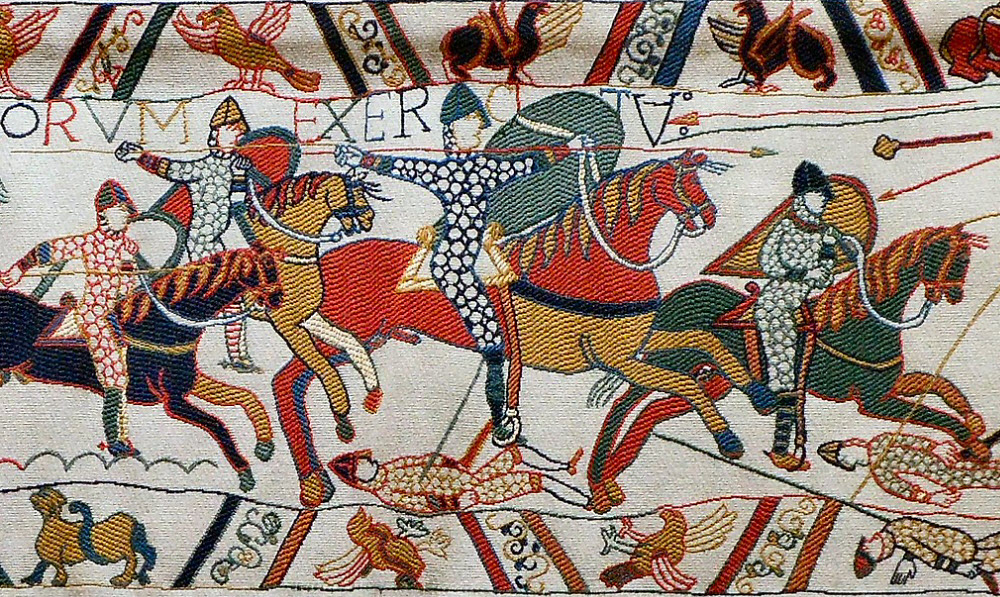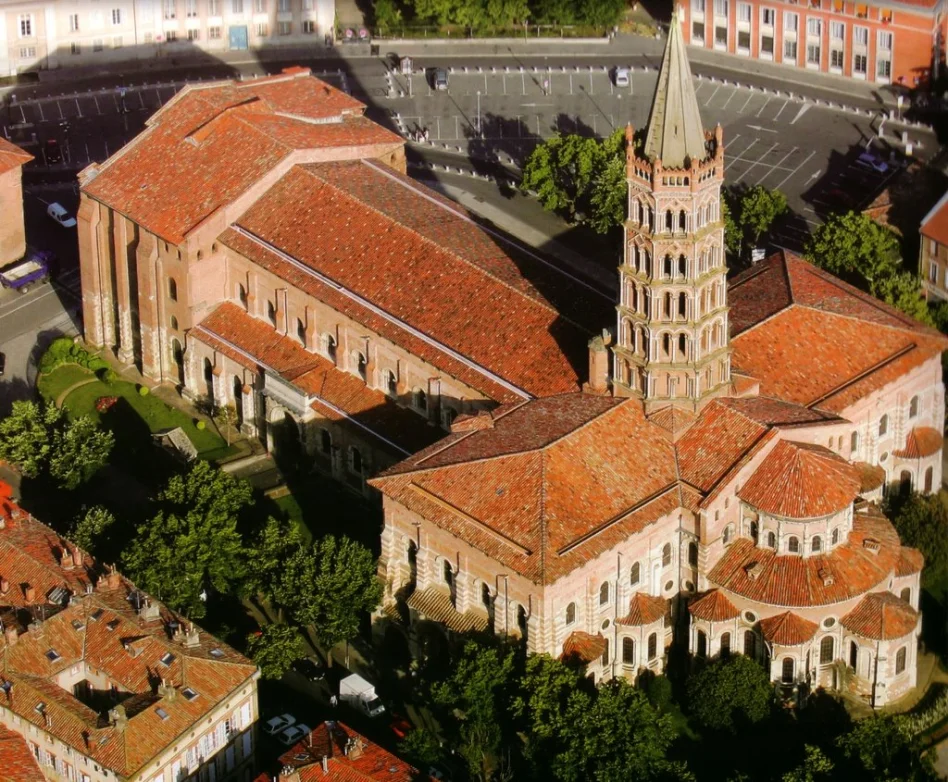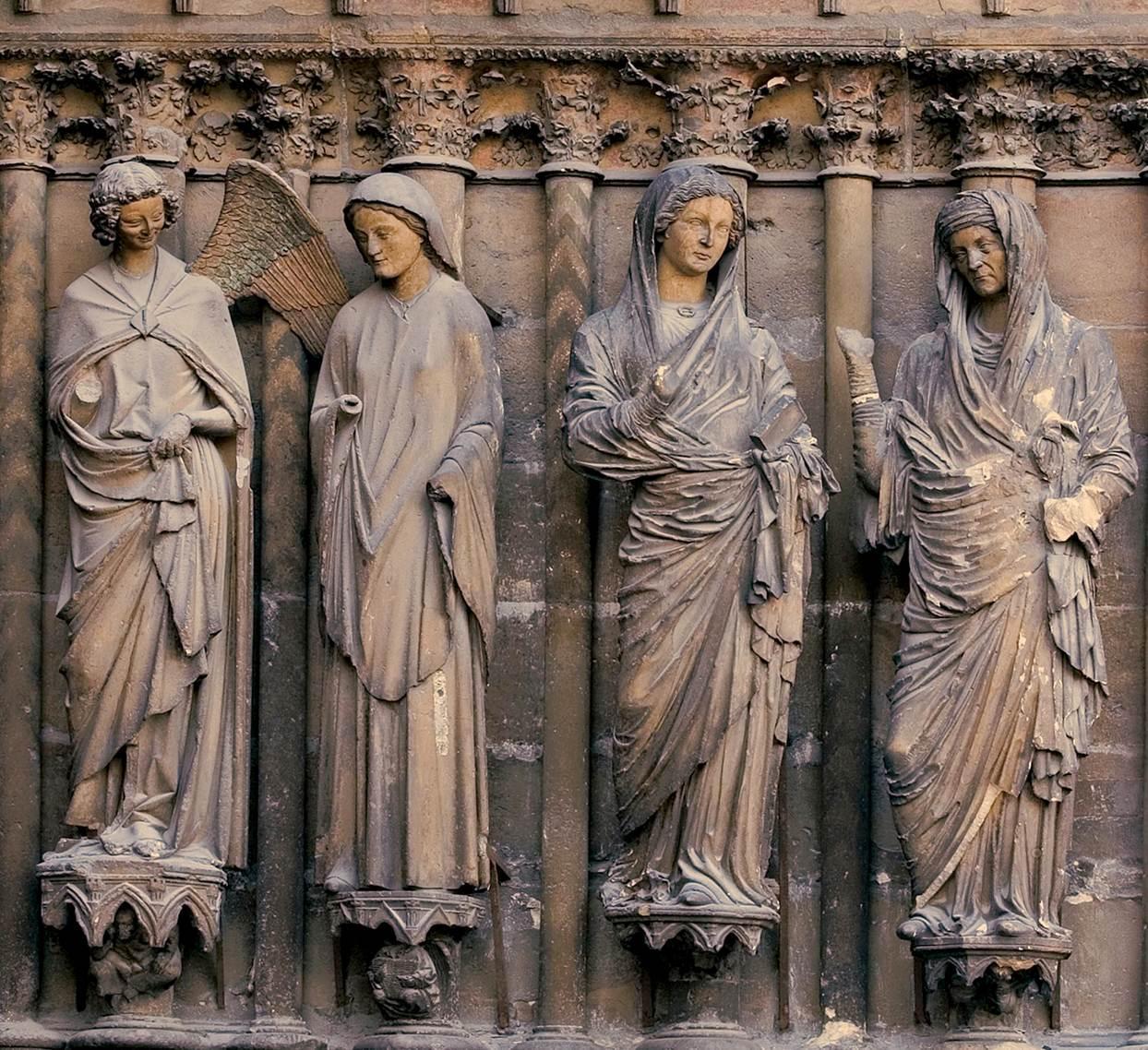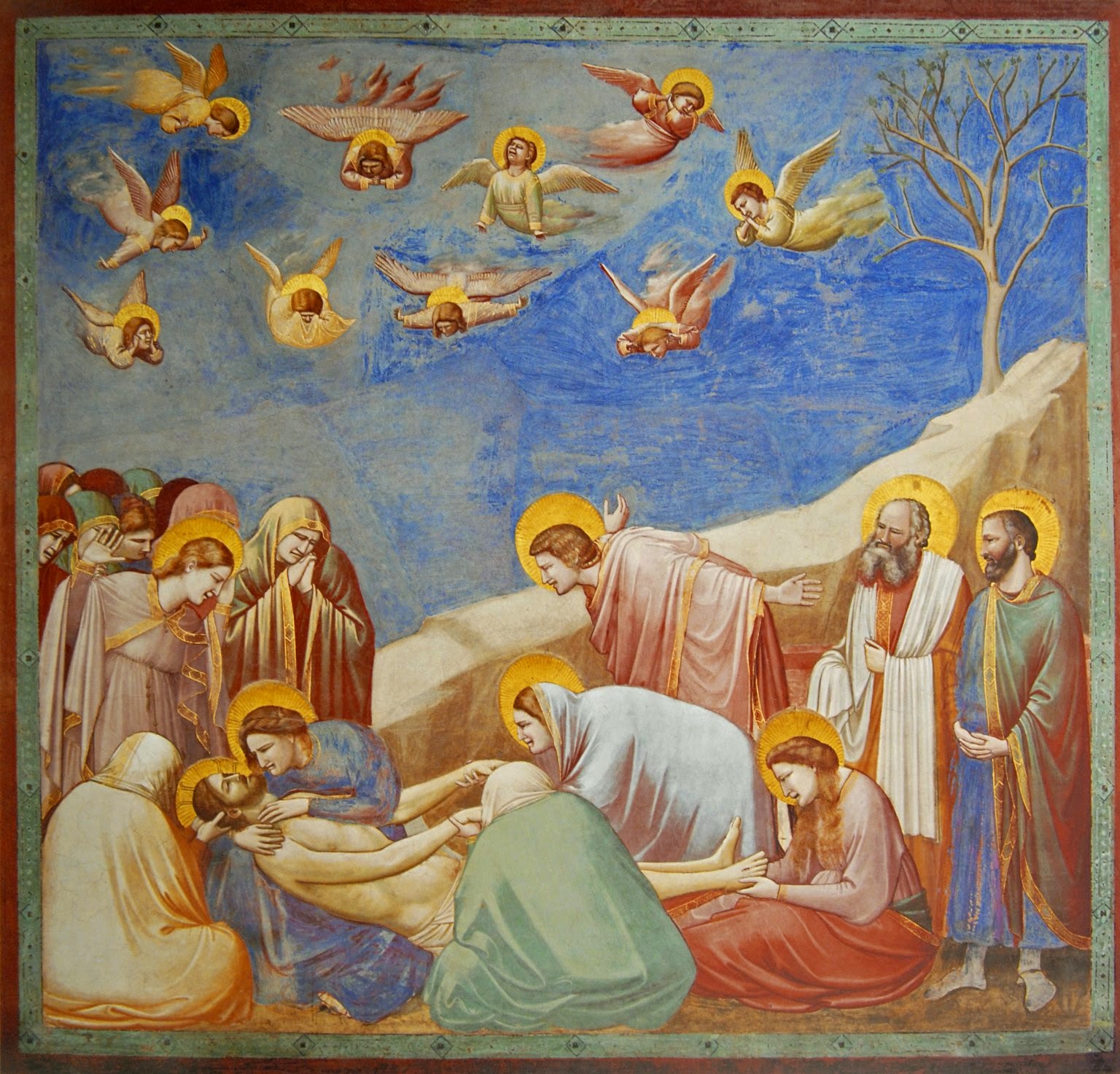romanesque and gothic art
1/26
There's no tags or description
Looks like no tags are added yet.
Name | Mastery | Learn | Test | Matching | Spaced |
|---|
No study sessions yet.
27 Terms
what was going on during the 6th-8th century?
dark ages
europe lost touch with classical learning and science
few documents survived to shed light on this era
what are the 4 iconographies
st mark
st john
st luke
st matthew
what is the book of kells (800)
celtic style of manuscript that takes us far from nature vs classical traditional of realism and portray of real world
written and decorated by Irish monks in Kells, escaping Viking attacks
perfection sought on the smallest scale humanly possible: fine technical execution
lack of concern for the accurate representation of the human body
moving away from physical representation (greek and romans) to spiritual; secular tto religious → reflects the growing power of the Church
st john’s significance on the book of kells
seen from the front, appears flat
2D decorative design that gives little hint of a solid body beneath
stylised human figure treated as a pattern of lines
curvilinear drapery falls in impossible folds

what is the significance behind the Bayeux Tapestry?
unique in medieval art
related to Romanesque manuscript illumination
depicts Norman (northern france) defeat of the Anglo-Saxons in the Battle of the Hastings in 1066
the battle united all of england and much of france under Norman’s rule
tapestries are rare in general
depicts in full detail an event at a time shortly after it occured (similar to roman art)
conqueror’s version of history, proclamation of national pride
depicts the whole chronicle of events including war preparations like cooking, working on trees for boats
animal motifs throughout the embroidery (dead and wounded animals below)
Harold’s face pierced by an arrow and killed
what was happening in romanesque europe in the 11th and 12th century?
barrel and groin vaults based on the round arch and revival of stone carving sculpture
thousands of churches and monastaries remodeled or newly constructed
religion was a key centerpoint for everyone → obsessive construction of churches
new feudal society led to full-fledged monarchies after Charlomagne’s death in 814 → france and england rose to real and lasting prominence
what were key features of romanesque architecture
rounded arches, vaulted ceilings, piers, columns for support, thick walls
relies on basic roman elements of the basilica plan
thick and heavy walls with less windows (sharp contrast to medieval architecture)
churches in the shape of a cross
narrow windows: less light and dark buildings
composite pillar-column (rome influence)
stone barrels (tunnels?)
what was the key features of romanesque culture?
appearance of monasteries and castles in the middle of agricultural lands to impress and show power
pilgrimages → social phenomenon of medieval life (Jerusalem, Rome, Santiago) → would worship relics (objects associated with saints, Jesus, Mary; part of their bodies?)
pilgrimage churches

describe the architectural design of the Saint-Sernin
latin-cross plan, proportions mathematically (1 long arm, 1 short arm)
exterior reflects the interior (v v different from islamic mosques)
each section of space is clearly and neatly separated
large interior, thick walls, closely spaced piers, engaged columns on the walls, stone vaults
barrel / tunnel vault system covers the nave based on the semicircular arch
superb acoustics → voices will echo through the vaulted space
no wooden ceilings → less threat of fires
require thick walls due to the pressure of the large vault, small and few windows, lack of direct light into the nave
nave elevated into 2 stories → typical from pilgrimage churches

why were sculptures important duing the romanesque period?
vast majority of ppl were illiterate
mission: decorative and didactic
equivalent of picture books
concentrated on Church Portals, tympanum (semicircular section above the doorway with horizontal lintel at the bottom)
tympanums usually has Jesus in the centre, in majesty and surrounded by a mandorla
what was the significance of the Moissac?
important stop church in the pilgrimage route to Saint James in Santiago de Compostela
elaborated series of relief sculptures
most prominent sculpture: apocalyptic vision of Christ’s second coming as king and judge of the world

describe the key features of this sculpture
enthroned christ → larger than life, Christ as the door to salvation
4 Evangelists (authors of the Gospels) → symbols of winged man, bull, lion, eagle
angels holding their scrolss to record human deeds for judgement
24 crowned elders musicians making music in praise of Christ, all facing him
on the pillars
six roaring interlaced lions on the front of the trumeau greet worshippers → protectors, ppl believed they slept with 1 eye open
trumeau’s right side: prophet displaying a scroll with long locks of hair and beard, passionate in his dreaming mystic
what is the significance of the vezelay mission of the apostles (1120-1132)
allegory of the mission to spread christian message and jesus’s ideas to the apostles and everyone
second archivolt: signs of zodiac and the labours of the months; message must be spread at all times
innermost archivolt and the lintel depict various types of ppl believed to inhabit the distant regions of the earth, based on ancient literary sources (like being half human, half animal; being tiny)
describe the relationship between pilgrimages and the veneration of relics
shrines housing body parts, objects (clothing, instruments of martyrdom) associated with the holy family or saints
pilgrims will travel thousands of km to visit a church and proclaim their faith in the power of saints and hope for a special favour (cure for disease, disabilities, repentance of sins)
source of revenue for churches → built grander and more luxurious shrines, modifications to architecture (longer and wider naves and aisles, additional chapels)
describe the key features of italian romanesque architecture.
retained timber roofs (unlike the stone in French Romanesque)
shows regional diversity
bell tower is detached from the cathedral
rich marbel incrustation (wall decoration consisting of bright panels of different colours)
how did the gothic era come about?
sustained peace in europe
widespread prosperity
deep spirituality
urban centers gained importance → prosperous merchants formed guilds → society becoming more complex
knowledge shifts from monasteries to universities
extraordinary technological innovation (esp in architecture)
what was the main differences between gothic and romanesque architecture?
gothic
look up to the skies
verticality emphasized
walls became thinner
vast windows of stained glass
pointed arches and vaults (ribbed vaults, fan vaults)
flying buttresses (reinforces the wall)
romanesque
solid
heavy
broad
buildings created a sense of security
semicircular arches, thick walls, closed spaced supports with few windows and dark interiors
“bound to earth”
describe french gothic architecture
located in city centres
rely on flying buttresses for structural support
rounded aspe, ambulatory, radiating chapels
altar oriented to the East, Church entrance West
what is the significance of the notre-dame (1163-1250)
population boom in paris due to rapid urbanisation → needed a new cathedral
early gothic → equilibrium of horizontals (romanesque) and verticals (gothic) → goes towards high gothic in 1194-1220
arch-shaped flying buttreses added after initial construction
naturalism of sculpture and stained-glass
gargoyles were glorified waterspouts
exception to the usual iconographic restrains of medieval art
irreverent → grotesque
built in the highest part of the city too bring mother mary closer to heaven (intended to be a terrestrial palace for her)
relic of mary: sancta camisia → a piece of cloth mary wore when jesus was born → extremely popular pilgrimage site
obsession with light
describe the architecture of the notre dame
facade with 4 buttresses, 3 portals, 2 towers, 1 rose window
towers strikingly dissimilar → 1 built in 13th century, 1 in 16th century in Flamboyant gothic
flying buttresses used throughout the whole building
minimal stone, maximum glass
famous stained-glass windows that allow for changing and flickering lights
what was the significance of stained glass during the gothic era?
educate an illiterate population about Christianity
pieces of coloured glass held by lead strips
added metallic oxides while glass was molten to create coloured glass
interior decoration → intended to be illuminated from behind by sunlight
help to transmit light into the cathedral
light with mystical qualities as an attribute of divinity (st augustine called god light)
used to document medieval tools, materials and working methods (chartres cathedral)
name some scenes depicted in stained glass in the notre dame
new testament: the life of jesus
blue virgin window: scenes from the life of virgin mary and jesus
st martin blessing the sick and wounded (scenes from the life of saints)
scenes from historical figures such as charlemagne (propaganda)
at the bottom of some stained glass windows: daily life scenes of those who contributed to the building → reflected catholic teachings still
bakers preparing bread → catholic teachings: bread becomes the flesh of Christ in the Eucharist ; bakers forming loaves → 12 loaves of bread, twelve apostles of christ + 11 silver loaves → the original 11 disciples
describe the architecture structure of the Amiens Cathedral (1220)
high gothic
almost complete elimination of heavy masses and thick walls
self-sustaining skeletal architecture
allows a lot of natural light in

describe early gothic statues
“pillar ppl”
elongated to fit narrow columns that house them
drapery lines as thin and straight as the bodies
stiff and disproportionate figures → few traces of naturalism

describe the key features of high gothic statues
in-the-round sculptures
acted out biblical scenes → figures turned to each other in conversation
contrapposto postures: rhythm of mvt, swaying hips, knees bent → roman portraits
naturalistic → wrinkles, drapery
describe the architecture of the westminster abbey
high gothic architecture → reached extremes of eccentricity beyond anything found in france
radiating ribs of fan vaulting
pendant vaults hanging down in knobs, denying gravity
elaborate designs cover the entire surface
chapel of Henry VII by roberto and william vertue (1503-19), tomb behind a grill

what is the significance of this painting? (giotto, 1305)
first paintings since the roman period to render human forms suggesting weight and roundness
anatomical structure beneath the drapery